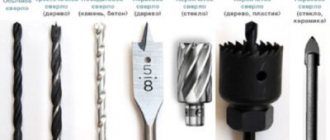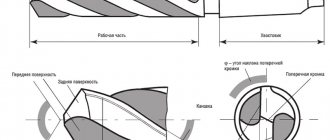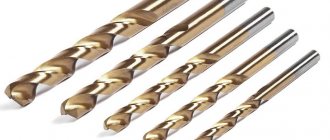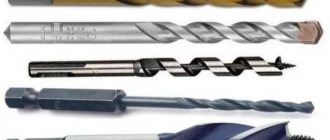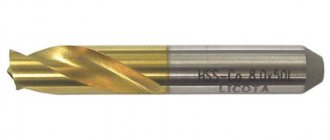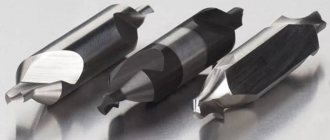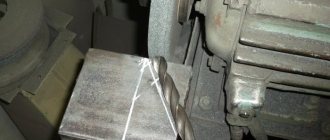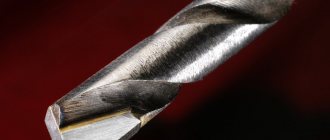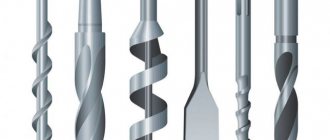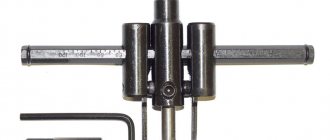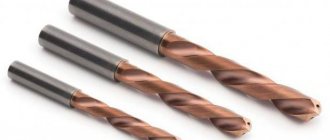To work with wood, you need to use high-quality tools. This is especially true for procedures related to drilling material. When choosing a suitable tool, take into account the type of wood and the diameter of the required holes. It’s easy to buy a good wood drill; there is a wide range of them on the construction market.
Types of wood drills
Modern models of electric drills are sold with a set of additional elements. One of the most important components of the tool is wood drills, which vary in shape and size. Sometimes the standard set is not enough to carry out complex types of work. In this case, you will have to purchase certain types of wood drills. The main parameter by which the products in question are classified are design features.
Feather drill for wood
The devices have two cutters on the sides. Their central part is shaped like a feather. Main features of the product:
- The presence of a sharp tip in the center of the pen.
- Perform sharpening with an inclination to the right side.
- Making a drill bit for wood in a certain ratio of the length and width of the cutting edge.
- The presence of a tail section shaped like a hexagon.
Sharpening of feather drills is carried out exactly according to the sample. The main thing is that its central part remains sharp. Drilling wood using feather drills should be carried out at high speed (200-500 rpm). The smaller the hole, the faster the tool must rotate. When using the drill in question, it is better to use tools with adjustable power levels.
Screw drill for wood
Another name for the device is shredder. The working section of a screw drill is shaped like a screw. Due to the unusual shape of the product, builders will not have to remove shavings from the wood. Advantages of a screw drill:
- Long working part. The maximum parameter is 600 mm, but in construction work a 450 mm screw-type wood drill is more often used.
- Possibility of making holes in thick and durable materials with high quality.
- The wide range of device diameters offered on the market is from 3 to 52 mm.
- There are two types of tips: conical and with special cutters.
It is recommended to install screw drills on electric drills. All work using them is carried out at low tool speeds. The smaller the diameter of the product, the shorter its working part should be. When working with screw drills, do not allow them to bend. Only in this case will it be possible to obtain even holes corresponding to the required dimensions.
Twist drill bit for wood
The devices are most often used when performing home construction work. In appearance, they are similar to what a screw-type wood drill looks like. The work of the drill occurs from the influence of pressure and rotation. The main advantages of a spiral drill include:
- No significant mechanical forces on the drill from workers. To obtain an accurate and even hole, they will only need to accurately guide the drill and control the power of the tool.
- The presence of a point at the end, which prevents the drill from sliding off the surface being processed.
Twist drills are inserted into an electric drill or hammer drill and give it the necessary rotational force. This type of drill is capable of not only making holes in wooden products, but also expanding holes already existing in the material. Spiral drills are used in the construction industry to work with metal and concrete surfaces.
Forstner drill bit for wood
The product has a number of advantages, due to which it is used when carrying out high-precision work. The devices are most often used in the manufacture of furniture. A forstner drill bit for wood helps to make holes up to 10 cm long and with a diameter from 10 to 60 mm. They are equipped with extensions (up to 300 m) for making deeper holes in wood. The main advantages of a set of forstner drill bits for wood:
- possibility of purchasing drills as a set (5-6 pcs.);
- permissible fixation of the extension;
- the ability to create holes at low drill speeds.
Ballerina drill for wood
The design of the device resembles a compass. The sharp part of the drill is located in the middle, and the cutting part is located at the edges. The ballerina has the widest range of all kinds of holes compared to what wood drills come in. Using a drill, you can make holes in material with a diameter of 30 to 140 mm. When purchasing a ballerina, you must be especially careful, since drills of this type are often counterfeited.
Advantages of the tool:
- possibility of fast processing of sheet blanks;
- drilling of any types of wooden surfaces: chipboard, fiberboard;
- The presence of a punch in the set, with which it is convenient to make marks on the material.
Hole drill bit for wood
The products are also called crowns. The main advantage of the devices is the ability to make holes of large diameters that cannot be made using pen and spiral drills. A core drill bit for wood resembles a ring with teeth in appearance. The main disadvantage of the design is the inability to make deep holes.
Advantages of crowns:
- carrying out work not only with wood, but also with plastic and drywall;
- formation of an even cut with a smooth inner surface;
- absence of noise and dust when drilling.
Wood router bit
Using the device, not only round, but also shaped holes are made. Drills are used by workers for complex processing of wooden surfaces. Holes of round diameter can be expanded using a milling drill to the required sizes and shapes. The tail part of the drill has the shape of a cylinder. Less common are wood drills with triangular, square and hexagonal tips.
The device also has significant disadvantages. One of them is the need to use powerful drills with a built-in cooling system. The rotation speed of the tool should be 1500 rpm. Some types of cutters are designed to work at low speeds, so the presence of power adjustment functions in the tool will be mandatory.
Flexible wood drill
The devices are designed for processing hard-to-reach surfaces. There are often situations when it is impossible to reach the canvas in a straight line. In such cases, builders use one of the non-standard types of wood drills - a flexible drill. The term itself does not have a completely correct name. It is the shaft for transmitting torque that is flexible, not the drill itself.
Advantages of the device:
- ability to work in cramped conditions;
- drilling any type of wood;
- elimination of drill slippage due to the self-centering tip;
Disadvantages of a flexible drill:
- impossibility of drilling holes of large diameter;
- work only at low drill speeds;
- bending the shaft to a certain level.
Drill with countersink for wood
If builders need to hide the heads of self-tapping screws, they first use a thin and then a thick drill. The procedure can be completed in one step if you use a countersink drill bit for wood. It allows you to make holes of the desired size in order to mask the connecting elements. Products with countersinks are more often used in the furniture industry for screwing in confirmatory screws.
Design features of the drill option under consideration:
- fastening in the body of a drill with a diameter of 4 mm, which can be changed if necessary;
- the presence in the set of a hexagon with which the clamping screw is released;
- presence of a depth limiter.
Long wood drills
The design of drills of this type largely depends on the diameter indicators. It is impossible to purchase both a long and thin drill on the market. The smaller the diameter of the drill, the shorter it will be. This prevents possible damage to the device during work. It is necessary to correlate the dimensions of the drill and the capabilities of the tool used when drilling holes in the material.
The disadvantage of a wood drill is that the long product is heavy. Experienced builders use low-speed mixer tools when working with such structures. For conventional drills, miniature products are selected. Drilling holes with such a drill will require a lot of effort. Giant drills are used only in non-standard situations.
Twist drill
Spiral wood drills are designed for drilling holes in wood of different diameters. Size grid from 3 to 52 mm. There is a point at the end of the drill that makes it easier to start drilling. Large drills (from 10 mm) are equipped with a hexagonal shank, which allows the drill not to rotate during the drilling process. This drill has a chip outlet.
During operation, you need to monitor the number of revolutions:
- with a drill diameter of up to 14 mm, you need to set no more than 1800 rpm for soft woods and about 750 rpm for hard woods
- with a diameter from 16 mm to 25 mm, the number of revolutions is up to 1500 for soft grades and 500 revolutions for hard grades
- with a diameter from 30 mm to 52 mm, it is worth setting 500 rpm for hard varieties and 250 rpm for soft varieties.
If you follow the recommended number of revolutions, you can increase the service life of the drill.
Drill lengths range from 80 mm to 600 mm. As the diameter increases, the length of the drill also increases. A tool with a diameter of 10 mm can reach a length of 450 mm. These drills are suitable for creating holes in logs and thick workpieces.
How to distinguish drills for wood and metal?
The easiest way to determine the purpose of a drill is to consider the method of sharpening it. Drills designed for wood have a center point. It prevents the tool from sliding off the surface. The peak is presented in the form of a pin or an acute angle. In models for metal processing, there is no such element.
Drills for metal and wood, the differences between which are visible visually, also have different angles. For the latter material, this figure is 90°; when working with steel, drills with a large inclination are used. Universal products have an angle of 120°. Wood is less dense than metal. When working with it, cheap gray drills are used. For drilling metal, choose products of a golden or black hue.
Which drill is better
Equipment is a consumable material and is consumed in large quantities. Hundreds of domestic and foreign companies produce instruments. In construction stores you can find products from concerns with an impeccable reputation and nameless products that do not have quality certificates. It’s not difficult to figure out which drill to use to drill concrete and metal; it’s more difficult to make a choice in favor of a specific brand. The decision made determines how many tools are needed to complete the work.
Taking into account the specifics of the tasks performed, the VyborExperta.ru team recommends the following products:
- Matrix 72357 95 – for working with sheet metal in the home workshop;
- Practice 774-474 – for bolted connections when assembling metal structures;
- Fit 36429 – for working with confirmants;
- Stayer 2944 – universal “ballerina” for holes of different diameters;
- Metabo Forstner 627594000 – for blind holes in chipboard and wood;
- Enkor 9365 – will help installers when laying electrical wiring;
- Bosch Promoline 2.607.019.435 is the best set for metal work.
Using this tool will increase profitability, increase productivity, and reduce costs for consumables. This is the best equipment, the benefits of which will be appreciated by home craftsmen and professionals.
How to choose a wood drill?
There are many types of products on sale. They differ not only in appearance, but also in purpose. When choosing a suitable drill, pay attention to several nuances:
- Product material
. It is best if the drill is made of metal alloys. They are characterized by a long service life and wear resistance. - No marriage
. When purchasing a device, you need to pay attention to its appearance. There should be no cracks or irregularities on the surface. Such a drill will leave defective holes, especially when using a wood router bit. - Parts color
. High-quality structures are coated with a chemical oxide that has a bright yellow tint. This set of wood drills can be used to make holes in hard materials: ash, cedar.
Wood drill sharpening
To carry out quality work, experience is required. Therefore, before sharpening a new wood drill, you need to hone your skills on previously used products. An important rule of the procedure is to preserve the original geometric parameters of the drill. Sharpening of drills for wood and other materials should be carried out at the same angle as at the manufacturer's factory.
The drill can be processed manually or using an electric sharpener. In the first case, a mild steel file is used. The procedure begins with tools that have a wide notch pitch. Finishing work on sharpening the drill is carried out using files with a needle file. Attention is paid not only to the cutting edge, but also to its reverse side. Sharpening a drill manually or mechanically is carried out only in good lighting.
